Fell On His Face Bible Meaning: Worship and Surrender
In biblical texts, falling on one’s face is a significant act of humility, reverence, and submission to God. Notable instances include Abraham’s encounter reaffirming the covenant (Genesis 17), Moses at the burning bush symbolizing holy ground, and Jesus in Gethsemane illustrating submission to divine will.
This gesture reflects deep recognition of God’s sovereign power and human frailty, symbolizing a transformative moment of spiritual alignment. Historically, this act has underscored themes of human obedience and divine authority, profoundly impacting theological discourse.
By exploring such biblical accounts, one gains deeper insight into the profound relationship between humanity and divinity.

Fell on His Face Bible Meaning: Posture of Worship, Reverence, and Submission
| Aspect | Description |
|---|---|
| Phrase Meaning | To bow low or lie face-down in reverence, worship, or fear before God |
| Key Scripture Examples | Genesis 17:3, Matthew 26:39, Revelation 7:11 |
| Spiritual Symbolism | Represents humility, surrender, and recognition of God’s majesty |
| Common Contexts | Occurs during divine encounters, prayer, repentance, or worship |
| Worship Posture | Demonstrates the heart’s posture of awe and respect |
| Faith Application | Encourages humility and reverence in seeking and responding to God |
Abraham’s Encounter With God

Abraham’s encounter with God, as recorded in Genesis 17, marks a pivotal moment in biblical history where the covenant between God and Abraham is reaffirmed, establishing profound theological implications for the Abrahamic faiths.
In this passage, God commands Abraham to walk blamelessly before Him and institutes circumcision as the sign of the covenant.
Abraham’s response of falling on his face signifies a profound act of reverence and submission, embodying the gravity of the divine-human relationship.
This act of prostration underscores the theological concept of humility before God’s sovereign will.
The reaffirmation of the covenant not only consolidates Abraham’s role as the patriarch but also sets a precedent for faith and obedience in the Abrahamic traditions.
Moses Before God’s Presence
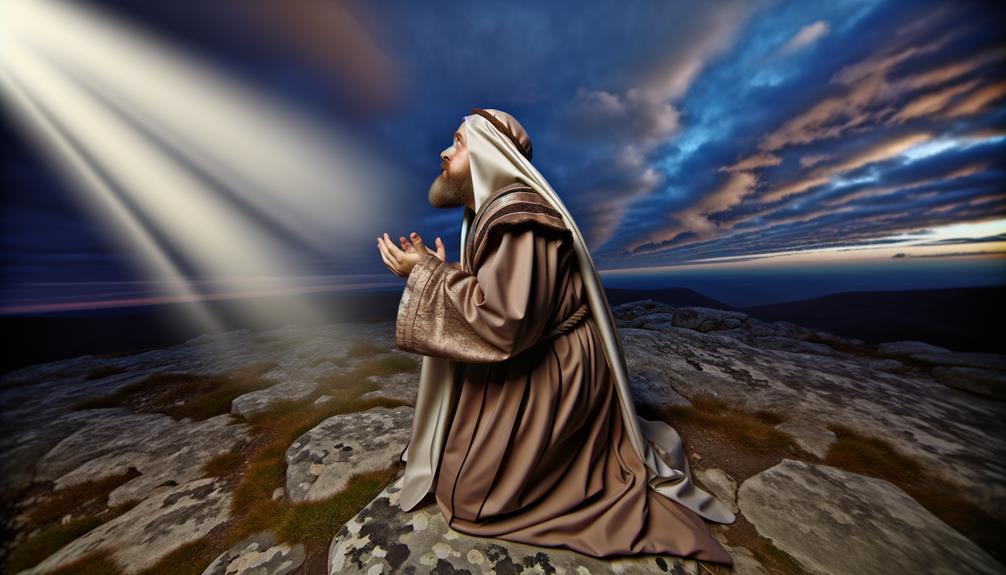
Moses’ encounter with God at the burning bush, as narrated in Exodus 3, serves as a profound theological moment that encapsulates the themes of divine revelation, mission, and the sanctity of God’s presence.
Historically, this episode signifies the commencement of Moses’ divinely orchestrated mission to liberate the Israelites from Egyptian bondage.
Theologically, it underscores God’s transcendence and immanence, as He manifests in a burning bush that remains unconsumed, symbolizing His eternal nature.
When Moses falls on his face, it is an act of reverence and recognition of divine holiness.
This gesture not only illustrates Moses’ humility but also underscores the sacredness of the ground, as God instructs him to remove his sandals, reinforcing the sanctity of divine encounters.
Joshua’s Act of Reverence
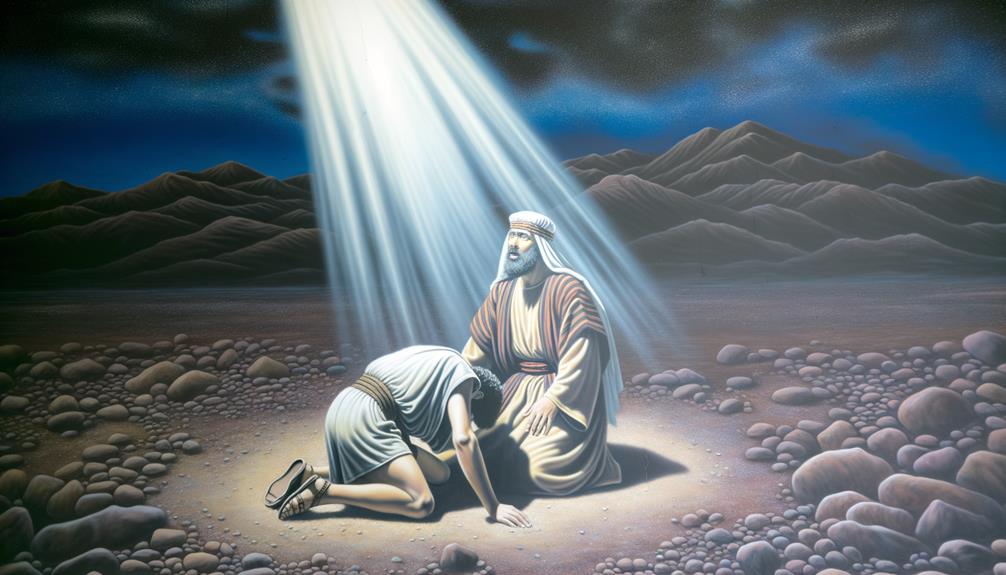
In a similar vein to Moses’ encounter, Joshua’s act of reverence before the Commander of the Lord’s army, as described in Joshua 5:14-15, carries profound theological and historical significance, underscoring the themes of divine authority and sanctity.
Joshua’s prostration signifies a recognition of divine supremacy, a pivotal moment that aligns him with the sacred mission ahead. This act of humility and obedience sets the tone for Israel’s conquests under divine guidance.
- Divine Encounter: Mirrors Moses’ burning bush experience, emphasizing continuity in divine leadership.
- Sacred Ground: Removal of sandals signifies entering holy territory, akin to Moses.
- Authority Acknowledgment: Joshua’s submission to the Commander reflects acceptance of God’s plan.
- Historical Continuity: Reinforces Joshua’s role as Moses’ successor.
Ezekiel’s Vision and Response
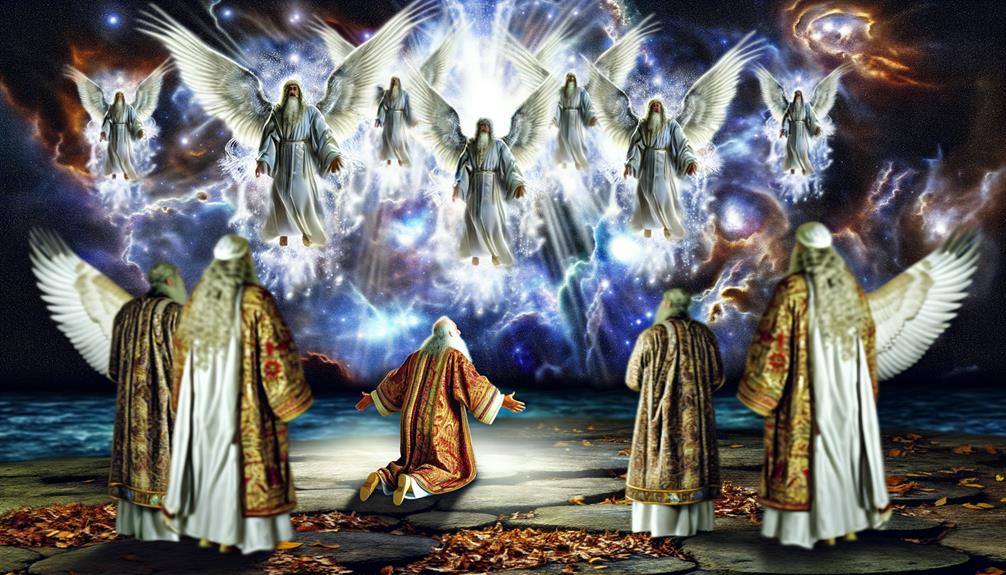
Ezekiel’s vision of the divine chariot in Ezekiel 1:1-28 serves as a profound theological and symbolic revelation, illustrating God’s majestic presence and sovereignty amidst the exile. This vision, marked by complex imagery such as the four living creatures and the wheels within wheels, underscores God’s omnipresence and dynamic involvement in the world.
Historically, this occurred during the Babylonian exile, a period of profound despair for the Israelites. Theologically, Ezekiel’s immediate response—falling on his face—signifies an acute awareness of divine holiness and human unworthiness.
This act of prostration reflects the appropriate response to divine encounters, emphasizing humility and reverence before God’s overwhelming glory and authority. Ezekiel’s experience encapsulates the tension between judgment and hope.
Daniel’s Moment of Humility
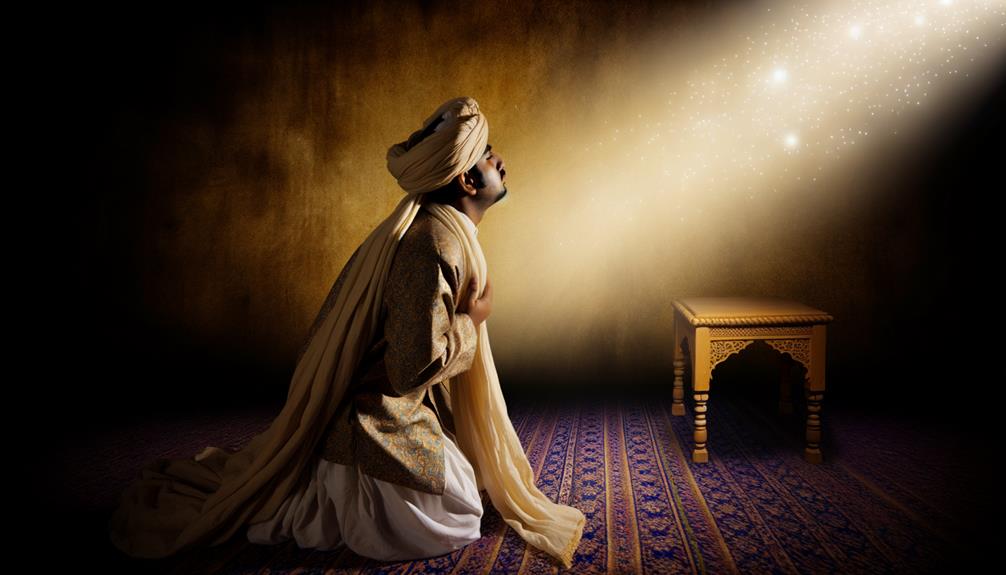
Amidst the political upheaval and spiritual challenges of exile, Daniel’s moment of humility, as described in Daniel 10:9, profoundly illustrates the appropriate response to a divine revelation, mirroring themes of reverence and self-abasement seen throughout biblical narratives.
Daniel, encountering a vision of an angelic being, falls prostrate, overwhelmed by the divine presence. This act of humility is emblematic of the proper disposition before God, emphasizing human frailty and the overwhelming majesty of the divine.
- Historical Context: Daniel is in exile, a period marked by intense spiritual and political turmoil.
- Theological Insight: The act underscores the necessity of humility in divine encounters.
- Symbolism: Prostration symbolizes total surrender and reverence.
- Comparative Analysis: Similar gestures are seen in other biblical figures.
Jesus in Gethsemane
Jesus’ agonizing prayer in the Garden of Gethsemane, as recounted in the synoptic Gospels, starkly reveals the depths of His human vulnerability and divine mission, encapsulating profound theological themes of obedience, sacrifice, and the intersection of human will with divine purpose.
Historically, Gethsemane was an olive grove, symbolizing peace and endurance.
Theologically, Jesus’ prostration and earnest plea, ‘Not my will, but yours be done,’ highlights His submission to God’s salvific plan.
This moment of intense prayer underscores His dual nature—fully human in His suffering, yet fully divine in His obedience.
It serves as a pivotal moment, illustrating the cost of redemption and the profound love that propels His journey to the cross.
John on Patmos
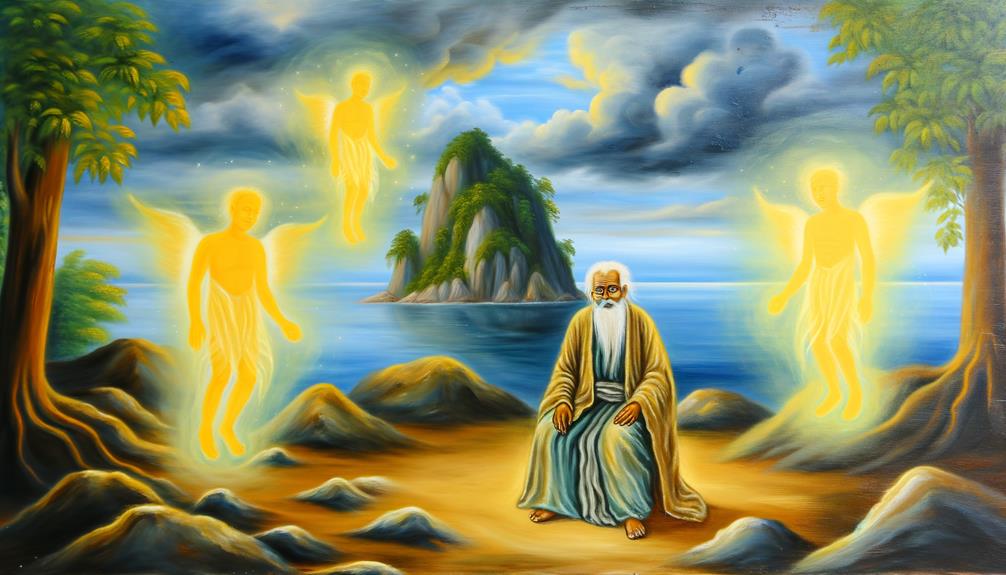
Following Jesus’ profound moment of submission in Gethsemane, the book of Revelation opens with the Apostle John, exiled on the island of Patmos, receiving a vision that reveals the ultimate fulfillment of God’s redemptive plan.
This vision, granted during a time of severe persecution under Emperor Domitian, serves as both a revelation and a reassurance to the early Christian community.
John’s experience on Patmos underscores several deep theological truths:
- Perseverance in Faith: John’s endurance exemplifies unwavering faith amidst trials.
- Divine Revelation: God communicates profound truths through visions.
- Eschatological Hope: The vision assures believers of future redemption.
- Prophetic Role: John’s role as a prophet mirrors Old Covenant figures.
These points provide a rich context for understanding John’s encounter.
Symbolism of Falling Prostrate

The act of falling prostrate in biblical narratives often signifies profound reverence and an acknowledgment of divine authority, reflecting a historical context where physical gestures conveyed deep spiritual truths.
This posture of submission underscores the worshiper’s recognition of God’s supreme power and their own humility. Theologically, it represents an intimate and unreserved surrender to the divine will, illustrating a pivotal aspect of faith and devotion in biblical tradition.
Sign of Reverence
Frequently in biblical narratives, falling prostrate is depicted as a profound act of reverence, symbolizing deep humility and submission before divine authority. This gesture encapsulates the recognition of God’s supreme holiness and the individual’s own unworthiness.
Historically, this act has been a physical manifestation of worship and awe, deeply rooted in ancient Near Eastern customs.
- Acknowledgment of Divine Majesty: Bowing face down signifies the acknowledgment of God’s unmatched grandeur.
- Expression of Penitence: It reflects a heartfelt contrition and a plea for mercy.
- Submission to Divine Will: This act demonstrates yielding to God’s sovereign plans.
- Invocation of Favor: It is often a posture assumed in seeking divine blessing.
- Covenantal Relationship: Falling prostrate underscores the covenantal bond between God and His people.
This symbolic act carries profound theological implications.
Act of Submission
In biblical literature, the act of falling prostrate is a potent symbol of submission, encapsulating the individual’s acknowledgment of and surrender to divine authority. This gesture, pervasive in both Old and New Scriptures, signifies complete humility and recognition of God’s supremacy.
Historical accounts, such as Moses bowing before the burning bush or Jesus in Gethsemane, illustrate this profound act of reverence and self-abasement.
Theologically, prostration embodies an internal posture of the heart, where human will yields to divine will. This act underscores a transformative moment of spiritual alignment, where the believer’s physical posture mirrors their inner devotion and dependence on God’s sovereignty.
Consequently, falling prostrate is not mere ritual but a profound expression of faith and obedience.
Lessons for Contemporary Faith
Drawing from the profound symbolism of falling on one’s face in the Bible, contemporary faith communities can glean valuable insights into the nature of humility, reverence, and submission before God. This act is not merely a physical posture but a spiritual disposition reflecting one’s recognition of divine sovereignty. Historically, biblical figures like Abraham and Moses exemplified this gesture as a response to God’s overwhelming presence.
- Humility: Acknowledging human limitations and God’s boundless power.
- Reverence: Demonstrating profound respect for God’s holiness.
- Submission: Surrendering personal will to divine authority.
- Repentance: Seeking forgiveness through a posture of sincere contrition.
- Worship: Engaging in an intimate, worshipful encounter with the divine.
Conclusion
The act of falling prostrate before the divine, as illustrated through biblical narratives, embodies the quintessence of humility, reverence, and submission.
Each instance—from Abraham’s encounter to John’s vision on Patmos—serves as a poignant allegory for humanity’s recognition of divine sovereignty.
This gesture, steeped in historical and theological significance, invites contemporary believers to emulate such profound acts of devotion.
It underscores an enduring truth: in the presence of the sacred, the soul’s natural response is one of deep, unwavering reverence.






